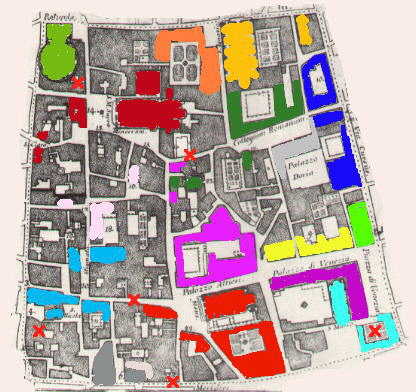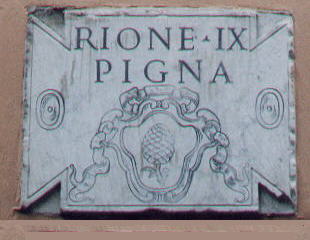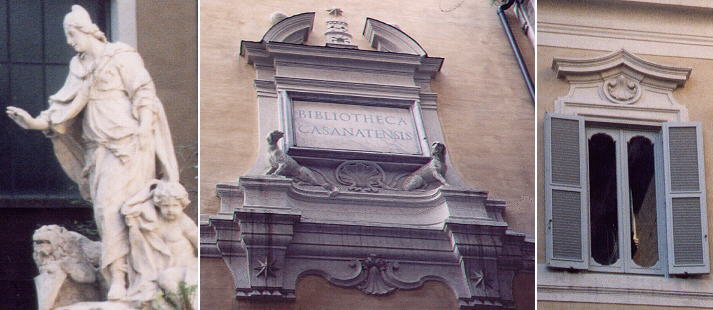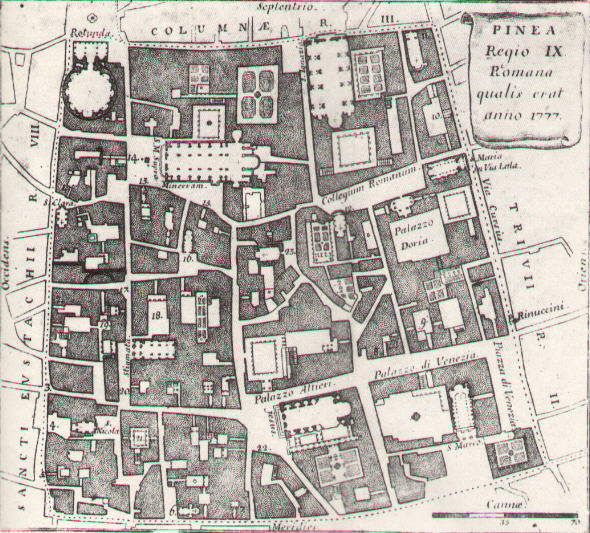  Rione IX Pigna
Rione Pigna was named after the colossal bronze Pigna (pine-cone) which
decorated a Roman fountain next to a Temple of Isis which occupied a vast area
(from today's S. Stefano del Cacco to Monastero Dominicano).
The Pigna was moved first to St. Peter's, where it was seen by Dante and later on to its current location
in Palazzo del Belvedere. It borders to the west on Sant'Eustachio, to the north on Colonna, to the east on Trevi and to the south
on Sant'Angelo and Campitelli.
Of its ancient past Rione Pigna retains first of all the Pantheon: of the five obelisks found in the area only one is still in Rione Pigna in Piazza di S. Maria sopra Minerva. Pič di Marmo, Madama Lucrezia and La Gatta di Palazzo Grazioli are the remaining evidence in Rione Pigna of the decoration of the ancient Temple of Isis. Elements of Terme di Agrippa (Agrippa's Baths) can be seen in Arco della Ciambella and behind the Pantheon. Rione Pigna acquired in the 1930s a new archaeological area including four Roman temples and a part of a Roman Portico. Rione Pigna is mainly characterized by large churches and palaces which can be roughly grouped as follows: XVth century: S. Maria sopra Minerva; Palazzo Venezia; Basilica di S. Marco. XVIth century: Il Gesų; Collegio Romano. XVIIth century: S. Ignazio; Palazzo Pamphili a Piazza del Collegio Romano; Palazzo Altieri. XVIIIth century: Palazzo Pamphili al Corso.
Legend of the numbers in the map 1) Casa di S. Caterina 2) Palazzo Bussi Pizzirani 3) Palazzo Origo 4) Palazzo Cesarini 5) Palazzo Sonnino Colonna 6) S. Lucia alle Botteghe Oscure 7) XVIIth century building where a Roman Portico was found 8) Palazzo Grazioli 9) Palazzo Pamphili (south side) 10) Palazzo Decarolis 11) Oratorio del Caravita 12) S. Marta 13) Palazzo Fonseca 14) Accademia Ecclesiastica 15) Palazzo Nunez 16) S. Giovanni della Pigna 17) Arco della Ciambella 18) Palazzo Marescotti 19) Palazzo Muti Berardi 20) Palazzo Strozzi 21) Collegio Calasanzio 22) Palazzo Cenci Bolognetti 23) S. Stefano del Cacco 
The red X mark the main changes which occurred after 1777: a) top left corner: the buildings around the Pantheon were pulled down in the 1880s; b) center of the map: in the second half of the XIXth century the street between Collegio Romano and Piazza della Minerva was enlarged by pulling down the buildings on its north side and by modifying the monastery next to S. Marta; c) lower part of the map (left to right): i) excavation of the Roman temples below Palazzo Cesarini in the 1920s; ii) enlargement in the 1880s of the street between il Gesų and SS. Stimmate di S. Francesco by pulling down the buildings on its north side; iii) enlargement in the 1930s of Via delle Botteghe Oscure by pulling down the buildings on its north side; iv) isolation of Palazzo Venezia in the 1880s by relocating the adjoining Palazzetto Venezia. The different colours group the monuments which are shown in the same page. You can also have a look at it from the Janiculum.
 or to
The Coats of Arms of the Popes or
to My Home Page on Baroque Rome or to
My Home Page on Rome in the footsteps of an XVIIIth century traveller or to
The Coats of Arms of the Popes or
to My Home Page on Baroque Rome or to
My Home Page on Rome in the footsteps of an XVIIIth century traveller
|
All images © 1999 - 2004 by Roberto Piperno. Write to romapip@quipo.it


